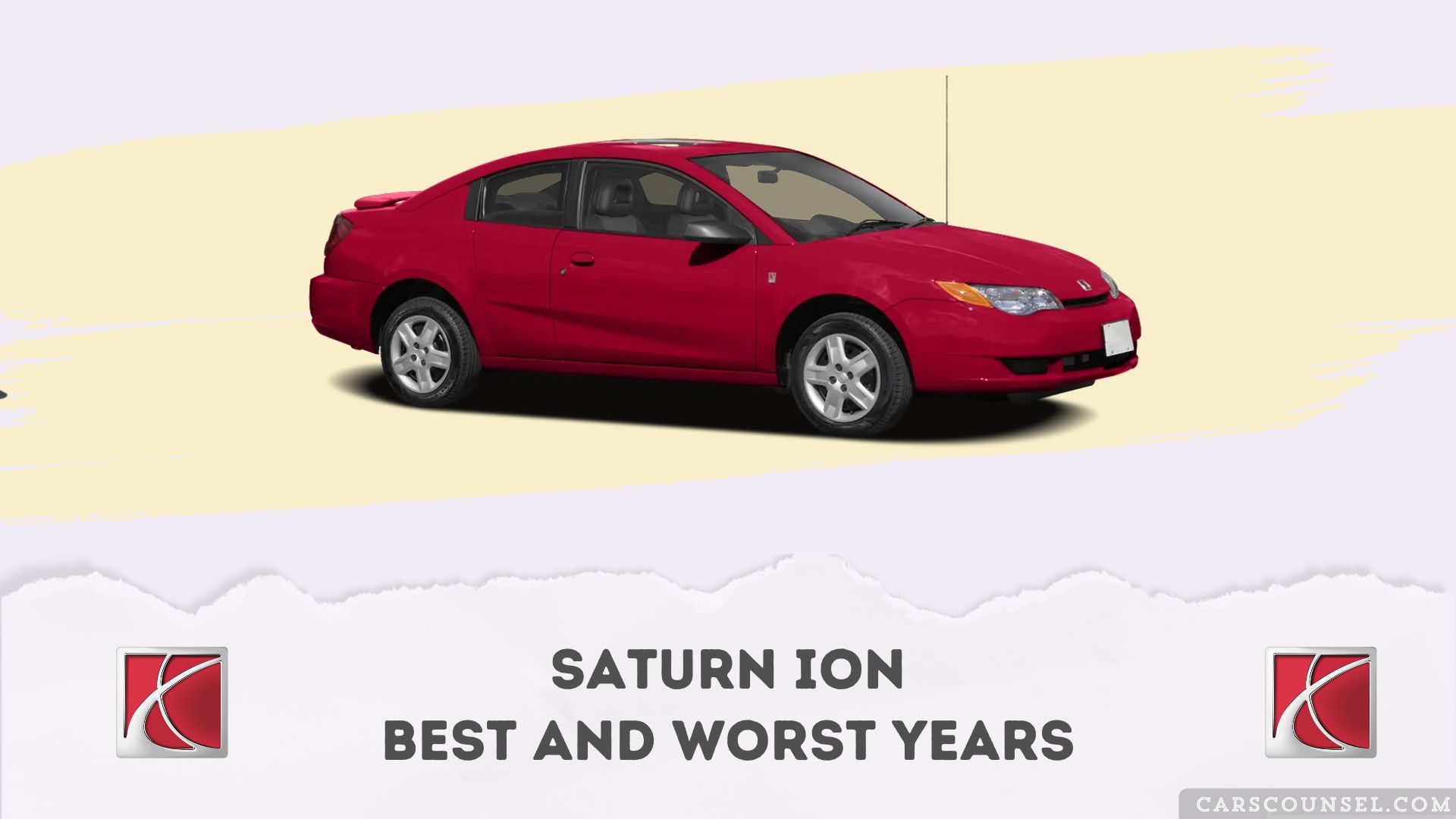You’re about to make a deal on a Saturn Ion, but beware – some models are ticking time bombs! The worst offenders are the 2003 models, plagued by design flaws that’ll leave you stranded on the side of the road. But don’t worry, there’s hope.
The 2004 and later saw significant upgrades, and they’re a whole different story. Want to know the secrets to avoiding a lemon and getting a reliable ride you deserve?

Quick Navigation
Key Takeaways
- Avoid buying the 2003 model year, as it has the most complaints and issues, making it the worst year.
- The 2004 model year received upgrades, making it a better option with fewer complaints and issues.
- The 2006 and 2007 models have fewer issues, making them good years to buy, but still requires attention to maintenance and inspection.
- First-year designs often have frequent issues, so it’s best to avoid them and opt for upgraded models instead.
- Research and inspect vehicles thoroughly before buying, regardless of the model year’s underlying issues.
The 2 Most Common Ion Problems
You’re likely aware that your Saturn Ion isn’t perfect, and that’s okay.
Like any model, it has its quirks. Two of the most common problems you might encounter are issues with the vehicle’s ignition system and faulty oxygen sensors.
These problems can cause your “check engine” light to come on, leading to costly repairs if left unchecked.
Regular maintenance, such as replacing spark plugs and oxygen sensors, can help prevent these issues from arising in the first place.
Stay on top of these problems to keep your Saturn Ion running smoothly.
What Ion Owners Complain About
The Saturn Ion’s reliability issues are a common gripe for many owners.
You’ll often hear complaints about malfunctioning sensors, and faulty transmissions. These problems can lead to stalling, hesitation, and even complete breakdowns.
You might also experience issues with the Ion’s electrical system, including flickering lights and malfunctioning wipers.
Additionally, some have reported problems with the car’s engine, such as excessive oil consumption and premature wear on parts.
If you’re considering buying a used Ion, it’s essential to research and address these common complaints to avoid costly repairs down the road.
Ion Generations
You’re likely familiar with the Ion’s production span, but you mightn’t know that it falls into two generations, each with its own set of issues.
The first generation, which ran from 2003 to 2007, is notorious for its problematic design and manufacturing flaws.
As you delve the specific issues plaguing each generation, you’ll gain a better understanding of the Ion’s overall reliability and performance.
Generation Overview
As Saturn ventured into the compact car market, it produced only one generation of the Ion, available in North American markets from 2003 to 2007.
You’ll find that this generation has a reliability rating of 31st out of 34 and a PainRank of 12.28.
Some key points to ponder:
- The 1st generation Ion has complaints reported on CarComplaints.com.
- It ranks 31st out of 34 in reliability, according to CarComplaints.com.
- You’ll find a high frequency of complaints, with 852 service bulletins issued.
- The Ion has a high number of reported issues, which can impact your ownership experience.
- The generation’s overall performance is reflected in its low reliability ranking.
First Generation Issues
Saturn Ion owners have faced numerous challenges, and it’s no secret that the first generation has its fair share of issues.
With a reliability rating of 31st out of 34, you’re likely to encounter problems, which can be severe, as indicated by the Ion’s 12.28 PainRank.
CarComplaints.com lists 330 complaints, with transmission and ignition switch issues topping the list.
The frequency of these complaints is high, and you’ll find 852 service bulletins and 12 recall campaigns documenting common problems and safety concerns.
In terms of the Ion’s first generation, it’s essential to be aware of these issues to avoid costly repairs.
Ion Key Numbers
The Ion’s production run was marked by several key numbers that helped define the model’s capabilities.
You’ll want to know these stats to get a better sense of what this car can do.
- 2.2L engine displacement
- 145 horsepower at 5,600 rpm
- 147 lb-ft torque at 4,200 rpm
- 27 mpg city fuel economy
- 35 mpg highway fuel economy
Recent Ion News
You’re likely curious about what’s been happening with the Ion in recent years.
In 2010, General Motors discontinued the Saturn brand, which led to the Ion’s production halt.
Since then, there haven’t been any significant updates or redesigns for the Ion sedan.
However, some owners have reported issues with the vehicle’s transmission, which has led to recalls and lawsuits.
Despite this, many Ion owners have reported positive experiences with their vehicles, citing their reliability and affordability.
You Think That’s Bad?
How does the Ion’s transmission troubles compare to other models? You might think it’s bad, but can’t remember other models that had similar problems.
- The Pontiac Aztek’s transmission issues were so notorious that it’s often cited as one of the worst cars ever made.
- The Chevrolet Aveo’s faulty sensor led to premature transmission failure.
- The Daewoo Lanos’s transmission problems were so widespread that it led to a massive recall.
- The Fiat Punto’s dualogic transmission was known for its jerky shifts and eventual failure.
- The Jeep Liberty’s transmission troubles were so severe that it led to a class-action lawsuit.
Ion Model Year Differences
As you examine the Ion model year differences, you’ll notice changes in the engine and transmission that affect the car’s performance.
The dash and radio changes will also catch your attention, with some models showcasing more advanced infotainment systems.
You’ll also find variations in the axles and rear bumper designs, which can impact the car’s overall appearance and functionality.
Engine and Transmission
The Saturn Ion’s engine and transmission have undergone significant changes throughout its model years, impacting its overall performance and reliability.
When considering a used Ion, you’ll want to keep these differences in mind.
- The 2003 year had a problematic timing chain that was improved in later years.
- The 2007 model year introduced variable cam timing, a feature considered less desirable by owners.
- Regular oil changes are vital for the engine and transmission’s longevity in the Saturn Ion.
- The engine and transmission are in their 7th year in the 2006 model, which is considered a more reliable option.
- The 2003 model year’s transmission was prone to failure, leading to a high frequency of transmission-related complaints.
Dash and Radio Changes
You’ve inspected the engine and transmission, now it’s time to focus on the dash and radio changes in your Ion.
The radio bezel design changed every year, offering a unique look for each model year.
From 2004 to 2005, the radio bezel remained the same, but 2006 introduced a new look with grey Recaros and an all-new radio bezel featuring silver vents.
The dash layout also differed slightly from 2004 to 2005, with 2006 having a distinct design.
These changes give each model year a distinct character, making it essential to inspect these details when buying a used Ion.
Axles and Rear Bumper
Ion’s axles underwent subtle changes across model years, with 2004 and 2005 sharing an identical design.
You’ll find slight variations in the axles across models, affecting the rear bumper’s fit.
- 2004-2005: Identical axle design, making parts interchangeable
- 2006: Axle redesign, affecting rear bumper fit and clearance
- 2007: Minor axle tweaks, ensuring a snug rear bumper fit
Rear bumper remained consistent across models, adapting to axle changes
Ion Reliability Expectations
Aiming to reach 120,000 miles in just 1.5 years, you’ll be relieved to know that the 2006 Saturn Ion‘s engine and transmission have proven themselves, with GM having learned from mistakes made by 2003.
As the 2006 model is the 7th year for the engine and transmission, you can expect better reliability.
Regular maintenance is key to longevity.
With 330 complaints reported on CarComplaints.com and a PainRank of 12.28, you’ll want to prioritize regular oil changes to guarantee engine longevity.
Advice for Saturn Ion Buyers
When considering a Saturn Ion purchase, beware of first-year designs, which are often plagued with problems.
You’ll want to prioritize regular maintenance to extend the life of your vehicle.
- Avoid buying first-year designs, as they’re often plagued with problems
- Regular maintenance is key to longevity, with regular oil changes vital for engine and transmission durability, and brake system maintenance essential to prevent major damage
- Check for missed maintenance on low-mileage vehicles, as a low odometer reading can mask underlying problems
- Research and inspect vehicles thoroughly before buying, as the Saturn Ion has a high frequency of complaints and a PainRank of 12.28
- Consider buying a 2004 or later model, as they received upgrades and are considered better options than the earlier models

